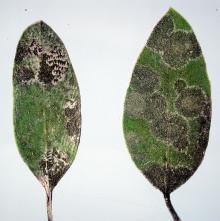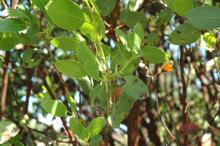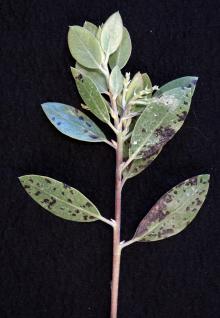See:
Kinnikinnick (Arctostaphylos uva-ursi) - Leaf Spot
Cause The OSU Plant Clinic has identified several different fungi from past samples of Manzanita including Cladosporium sp., Coniothyrium sp., Epicoccum sp., Exobasidium sp. (leaf gall), Monochaetia sp., Pestalotia sp., Pestalotiopsis sp., Phomopsis sp., and Pucciniastrum sparsum (rust). There could be as many as 15 different fungi, which have been reported from the PNW. For all these foliage diseases; however, airborne or water-splashed spores infect young leaves during wet weather, often in spring. The rust alternates between spruce and various species of bearberry including manzanita.
The fungus Pestalotiopsis can behave either as an endophyte not causing disease or as a pathogen. As an endophyte, the fungus resides in apparently healthy plant tissue until signals from the environment or the plant itself trigger further growth and reproduction. This adaptation allows the fungus to remain dormant and overwinter in a host without causing disease symptoms. As a pathogen, it often infects and grows in plant tissues that have previously been stressed. Stressors that predispose plants to this disease include drought, waterlogging, hail damage, transplant shock, and injury caused by spray applications of chemicals.
Symptoms Brown, dead, or dying spots on leaves. Many of these leaf spots will look similar and can be difficult to identify from casual observations. A few might have more distinctive symptoms such as leaf rusts or leaf galls.
Leaf gall aphid symptoms are similar to leaf galls caused by Exobasidium.
Cultural control
- Avoid overhead irrigation that keeps foliage wet for extended periods.
- Rake and destroy fallen leaves. Remove and destroy infected leaves from plants, where practical.
- Space plantings and prune to improve air circulation.
Reference Farr, D.F., Bills, G.F., Chamuris, G.P., and Rossman, A.Y. 1989. Fungi on plants and plant products in the United States. APS press.




